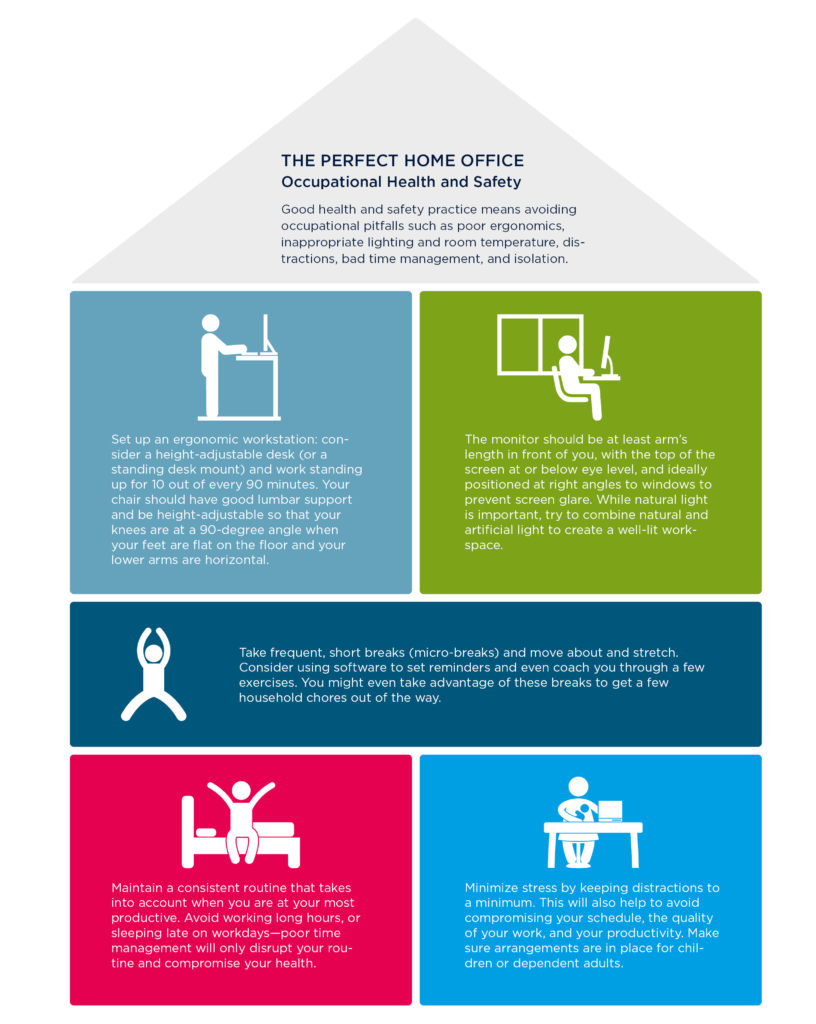In this series, we look at different ways of getting the creative juices flowing. This time, we focus on techniques for maximizing productivity while working from home. With the right approach, it’s possible to create a harmonious work-life balance that nurtures our physical, emotional, and mental well-being.
The nine-to-five schedule is a concept that dates back to the American labor unions of the 1800s. It is quickly becoming obsolete thanks to technology and the ability to work from anywhere. Working from home sounds ideal in theory, eliminating the daily commute and affording you the flexibility to arrange your own schedule, and potentially offering a better work-life balance. In practice, though, it can be a very different picture and it does take discipline; with a work life and a home life occupying the same space, it’s often difficult to keep the two separate. So when you find yourself working from home—and most of us will at some point in our careers—how do you go about building a barrier between your professional and private lives so that neither bleeds into the other and you stay creative, productive, healthy, and safe?
On average, remote employees worked 1.4 more days every month, or 16.8 more days every year, than those who worked in an office.”
2020 study by Airtasker of 1,004 full-time employees
For some professionals, such as writers, translators, or graphic designers working alone and, for the most part, on a freelance basis, teleworking is the ideal set-up, offering tremendous flexibility in terms of time management. There are also employers who recognize the benefits of allowing their staff the freedom to work remotely either full or part-time, equipping them with all of the technology they require to work seamlessly as if they were physically in the office. Then there are extraordinary circumstances such as the coronavirus pandemic that are forcing us to entirely rethink the way we work. Whatever your situation, the shift in mindset required to move from an office to a home-working environment can be challenging; success in a home workplace depends on the creation of a working environment designed to promote efficiency and well-being away from the traditional office.

What Is Work-Life Balance?
Getting into the right frame of mind to be creative at work depends largely on having the right work-life balance and this is something we should not underestimate. But what does that really mean, and what does it entail? Essentially, work-life balance refers to how we prioritize our professional and private lives and how we can achieve a satisfactory equilibrium between the two. While the availability of sophisticated technology has made it easier to work remotely, by removing the importance of physical location it has also blurred the lines between our working and home lives. The internet, mobile technology, teleconferencing tools, and cloud-based software, for example, now enable us to work from almost anywhere. But what this also means is that we are in danger of being “always-on.”
A harmonious work-life balance has several positive effects, such as reduced stress, a lower risk of professional burnout, and a greater sense of well-being. Getting it right can have tremendous benefits for employers as well: lower overheads, reduced absenteeism, a more satisfied, motivated, loyal, and, therefore, more productive workforce, savings in office space, and a reduction in the company’s carbon footprint. Businesses have begun to embrace more flexible work schedules, making it a priority to accommodate their employees’ individual needs and helping to improve their mental and physical health. It is also a strategy that allows these companies to remain highly competitive, as this greater flexibility allows them to attract and retain top talent.
To achieve equilibrium, it’s also essential to remember that there is no perfect work-life balance, that the goal posts are shifting on an almost daily basis, and what works for one person may not work for someone else. As long as we remain realistic, we can allow the balance to ebb and flow between work and home as demand dictates. It is more about your output than the number of hours you put in. Balance is a long-term goal, not a daily one. As founder of career mentoring group Boss in Heels, Heather Monahan, says: “It is important to remain fluid and constantly assess where you are versus your goals and priorities.”
If you aim to achieve proper work-life balance, it makes sense to think of your work life and home life as two different states of mind—and learning how to switch between the two can be of great benefit. Here’s how to get started.
- To create a state of home, try conjuring up a few relaxing memories—places and times that firmly establish a comfortable, welcoming, even cozy environment and that truly make you feel “at home.” It might be childhood memories of a summer vacation spent adventuring in the woods and paddling in the stream, family excursions, or helping Uncle George to restore his vintage Triumph Bonneville motorbike.
- Create a productive mental work state by thinking back to a project that thoroughly absorbed you and made time fly. Total absorption comes from doing something you are passionate about, and this will ultimately push you to be more creative and productive.
- Create physical spaces that represent “work” and “home” and fill each space with objects that reinforce the function of that space. Make sure you keep these spaces separate by establishing boundaries; prevent work-related objects from infiltrating your private space, and vice versa.
- Remember that whenever you enter your workspace, you are there to do just that: work. Avoid “social suck” at all costs—would you check Instagram or Twitter during a work meeting? It’s a distraction, and unproductive.
- The impact of routine and structure on your state of mind cannot be emphasized enough. Without the commute the line between home and work becomes even more blurred, so use the time gained to inject some creativity into your routine by getting up early, exercising, breakfasting with the family—anything to fire you up for the day and inspire your best work.
The Creative Space
Of course it depends on the individual, but working from home can generate unprecedented opportunities for clarity and focus, and creativity can improve as a result. Working in an environment where you feel relaxed, comfortable, and free from the distractions of the office—such as meetings or drive-bys from colleagues—can allow you to deliver some truly unique work. A little bit of distance from the traditional office can enable an objectivity that is so crucial for fresh thinking; without distraction we have quiet to think, and to look at the world outside of the office, from a different perspective. This is often an untapped source of inspiration and creativity.
Remote working can also result in a shift in the landscape in terms of personalities. Working from home can be an opportunity for less dominant personalities to shine. Some of the most creative voices are never heard in meetings, so for introverts who are less likely to speak up, working from home can be energizing. Meanwhile, because teleworking is very much based on trust, everyone is keen to show high levels of productivity, which can promote a broader depth of creativity from every employee as each voice competes to be heard.
For those who draw inspiration from personal connections and collaboration, the opportunities for strong connectivity through technology are numerous. The increase in internet speeds has made video conferencing widely available to everyone, allowing daily inspirations to be shared among colleagues, or even exercise classes or musical renditions to be livestreamed, or virtual coffee dates scheduled whenever a mental break is needed.
For us, there are two key concepts for the remote creative process: over-communicating, and most of all, trust.”
Juan Javier Peña and Ricardo Casal
Partners and Executive Creative Directors, GUT
Staying Productive
It emerges that the golden rules for staying productive while working from home include having set working hours, taking regular breaks, and eliminating distractions. While remote working can be an opportunity to improve your work-life balance, it does take discipline to prevent your work from disrupting your personal life. It is vital to create habits that establish firm boundaries between the two; before you start work in the morning you might go grab a coffee from across the street or take a walk, mimicking the commute and allowing you to transition from one space to the other with a clear boundary and a clear head.
An increasing number of companies are recognizing that a more flexible work life is leading to a happier and more productive workforce, and are therefore coming to regard teleworking as an asset. Working from home is no longer a privilege, it is becoming the new norm, where trust is more important than ever. Trust is the attribute that underpins the most creative and high-performing teams. At the end of the day, inspiration can strike anywhere, which is perhaps why the flexibility of remote working invites innovative thinking, and creative people will always find a way to create—be it in the office, or at home.
While some may thrive in a less distracting environment, others may feel isolated and lonely. Working remotely means that a certain degree of isolation is par for the course, so maintaining co-presence and communication will require you to get creative in finding alternative ways to keep in touch. Here are a few tips to help make things easier:
- Talk to your superiors and colleagues about how (e-mail, phone, messaging tools) and when (frequency) you will keep in touch and coordinate your availability.
- Create a communication network with other colleagues using teleconferencing and messaging tools. Bouncing ideas off colleagues will keep the creativity flowing.
- Be proactive in contacting your supervisor and workmates, and speak up if you need advice or support.
- Stay in the loop by regularly checking the company Intranet and keeping in touch by e-mail, and establishing a mutual feedback process with superiors and colleagues to keep track of progress.
- Keep the communication flowing by organizing virtual coffee dates or water-cooler breaks via messaging tools, video services, or even an internal social network.
- Consider adopting a pet if you are home full time; they make great companions and will always keep you grounded. Dogs are great for bouncing ideas off—and pretty much never answer back—, while going for walks can be a fantastic source of inspiration.
- Remember that the positive side of isolation is focus!



